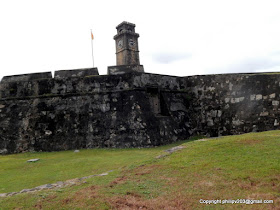The Galle Dutch Fort is a rare historical jewel protected by dark, thick stone walls – with the endless ocean on one side. The roads inside the Galle Fort have hardly changed, like the squares on a chess board crisscrossing in regular patches. Straight and narrow lanes branch in and out inviting the visitor to a delightful walk into the 17th century.
Today’s Peddler Street was called “Moorse Kramerstraat” by the Dutch, Lighthouse Street was “Zeeburgstraat and Middelpuntstraat”, Hospital Street as `Nieuwe Lijnbaanstraat and Lijnbaanstraat (New Ropewalk Street), Old Ropewalk Street as Oude Lijnbaanstraat (Old Rope-Walk Street), Church Street as Kerkstraat, Parrawa Street as “Parruasstraat” and Chiando Street as “Chiandostraat”. Through this memory walk one would however miss the 17th century familiar vendors who traded in cinnamon, lace, elephants, tortoise and turtle shell ornaments besides the famous down south sweetmeats like “bondi aluwa” hanging in garlands from the shoulders of vendors.
Built by the Portuguese in 1620, the Galle Fort was fortified by the Dutch in 1667. The historical walk would also revive memories of places within the Fort as Sao Lago (Sun Bastion), Middelpunt (Moon Bastion), Cavaliar, Sao Antonio and Zeepunt (Star Bastion), Porte da Muro (Wall Gate), Porte da traisao (Treason Gate)Santa Cruz and Zwarte Fort (Black Fort), Akersloot Bastion, Halve Maanrje (Utrecht Bastion or Half Moon), Nieuw Werk (Klipenburg Bastion) Nieuwe Punt (New Point), Halve Bolwerk (Half Bastion)- Aeolus Bastion, Triton Bastion, Neptune Bastion, Aurora bastion, Rocky Bastion, Negotie-mantoor (Trade Office).
This original rare old antique engraved print from: “Oud en Nieuw Oost-Indiën” (Old and New East Indies) by François Valentyn / Valentijn, published in 1724-1726.
source : lankapura.com
source : lankapura.com
Ancient monuments within this historical complex included the Lighthouse, the clock tower, the first Dutch Reformed and Anglican churches, the Meera Mosque, the Buddhist Temple, and the Commander’s Residence. Worthy of mention is the Dutch Reformed Church with its baroque facade and the usual double scroll mouldings on its gables which testify to indigenous influence. The military architecture of the Fort is European in design. The unique Galle Fort is still the best preserved fortified city in South Asia.






























